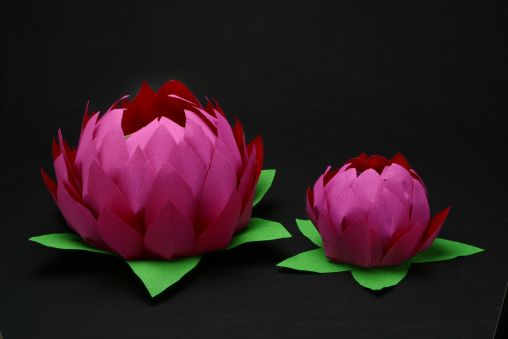Activity
Create a Lotus Lantern for the Lotus Lantern Festival
Objective:
Students will: 1.) Learn that Buddhism is a religion founded by an enlightened young Indian prince who became the Buddha. 2.) Learn how the Buddha’s birthday, a national holiday, is celebrated in Korea. 3.) Discuss how the lotus flower is symbol of purity and wisdom. 3.) Construct a lotus blossom lantern.

- Locate Korea on a map.
- Introduce a general history of the life of Indian prince Siddhartha Gautama, who became the Buddha. Discuss with students how the teachings of the Buddha spread from India through Central Asia and China; and how these teachings arrived in Korea in 372 CE.
- Explain how the Buddha’s birthday is celebrated in Korea.
- Have students research the Lotus Lantern Festival using the internet.
- Discuss the symbolism of the lotus flower in Buddhism. Compare and contrast this ceremony to those celebrated in the United States.
- Using a pencil, have students trace the lantern frame stencil twice on the poster board.
- Cut out the shapes with scissors, and tape them together to form a row of eight connected panels. (Please note that the stencil provided needs to be enlarged 200 percent.) An alternate method for making a lantern frame is to use a large tissue box as described below (see illustration above):
- Cut open one large tissue box lengthwise.
- Place the lantern frame stencil on top of the tissue box. Trace the stencil twice, one tracing directly above the other.
- Cut out the shapes and tape them together to form a row of eight connected panels. Each panel should be octagonal.
- Tape the ends of the row of panels together so that they form a cylinder.
- At the bottom and top of the cylinder, gently fold the top and bottom of each octoganl panel over at an angle and tape together. The frame should now have the appearance of a small ball.
- Fold the pink crepe paper along the grain of the paper.
- Using the lotus petal stencil, draw and cut out petals for the lantern.
- Gently fold over and pinch the bottom of each petal to give it a concave shape.
- Starting from the top, tape rows of pinched paper petals onto the frame until it is covered.
- Next, cut the green crepe paper along the grain to form five large petals (slightly larger than the lotus petals) and tape them to the bottom of the frame.
- Using the hole punch, make two holes on opposite sides at the top of the frame. Tie a wire through the holes to create a hanger for the lantern.
- Using markers on a small rectangular piece of white paper, have students write their wishes and the names of their immediate family members and/or deceased relatives.
- Finally, tape this paper to the bottom of the lantern so it dangles when the lantern hangs.










